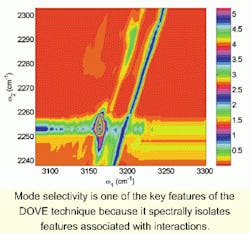SPECTROSCOPY: Infrared lasers identify molecular bonds
Researchers at the University of Wisconsin-Madison (Madison, WI) are using infrared (IR) lasers, choreographed to focus on a small sample, to read barely detectable vibrations of molecules. Moving beyond traditional IR spectroscopy, the technique also provides information about the connection between the different bonds in a molecule or between molecules. According to researchers John Wright and Wei Zhao, the process, called doubly vibrationally enhanced (DOVE) four-wave mixing, is essentially an optical analog to two-dimensional nuclear-magnetic-resonance (NMR) spectroscopy and provides an alternative for studying biological systems, especially complex materials such as proteins.
Like NMR, the technique developed by Wright and Zhao tunes lasers to two frequencies at which molecules vibrate. A key difference is in the use of lasers to stimulate two vibration molecules of interest, allowing the capture of the spectral signatures of connections within and between molecules.
According to Wright, four-wave mixing spectroscopy is based on the interactions that result when three overlapping laser beams induce a nonlinear polarization in a sample, which, in turn, drives a fourth output wave. The process is multiplicatively enhanced from the resonances that result when combinations of the three laser frequencies match spectral transitions in the material. The multiple resonances can provide spectral selectivity when they drive specific molecules or vibrational modes because those transitions are selectively enhanced. In the process, cross peaks can only be observed if there is coupling between the vibrational modes. One benefit is that the absence of uncoupled features eliminates the need to detect changes so the cross peaks can be directly measured in two-dimensional (2-D) spectra without the need for further data treatment.
The DOVE processes can be described as two IR transitions and a Raman transition that occur simultaneously during the presence of the excitation beams. The researchers' four-wave-mixing experiments use an injection-seeded Nd:YAG laser to pump two optical parametric oscillators/amplifiers that generate two IR laser beams tunable from the near-IR to approximately 2150 cm-1 in bandwidths of roughly 3-5 cm-1. The 532-nm Nd:YAG output provides the third beam. All beams are linearly polarized in identical directions, with beams one and three collinear and the second beam crossing them at an angle between 10° and 20° to provide phase matching. The output beam is monitored with filters and a photomultiplier tube.
Although IR absorption spectroscopy is often compromised by absorption from a solvent, particularly in biological systems in which water provides strong absorption, Wright and Zhao think the DOVE four-wave-mixing process overcomes this limitation (see image). The researchers used acetonitrile in different mixtures as a model system to demonstrate the spectral selectivity that allows DOVE methods to remove the spectral congestion from vibrational spectra of complex mixtures and to discriminate against a strong water background.
About the Author
Paula Noaker Powell
Senior Editor, Laser Focus World
Paula Noaker Powell was a senior editor for Laser Focus World.
